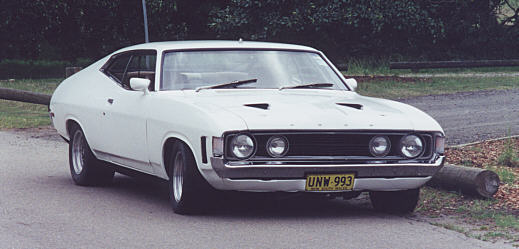

This photo was taken in Sydney's Centennial Park the day I got it back from the repair shop after it was hail damaged in 1999. The car is an original XA GT Falcon produced in November 1972. The model won Bathurst in 1973 as a production car.
It is a 351 cubic inch Cleveland V8 running very close to its original equipment. Minor modifications extend to things like it uses forged pistons, a high volume oil pump and a clutch from an F100 truck as the original multi-plate clutches are fragile and very difficult to get. It has a "bull nose" top loader manual gear box from an XW series Falcon GT as it is a stronger gear box and has a higher 1st gear ratio that makes it somewhat less inclined to wheel spin when taking off. The original differential ratio of 3.01 has been retained as the vehicle is used for country driving and is set up for that purpose.
It is set up with adjustable KONI shock absorbers both front and back and is fitted with a 28 millimetre front sway bar and low profile tyres as its primary purpose is as a country car. The original 4 turn steering without and power steering gives the characteristic of very accurate steering with excellent feedback while driving under many different conditions. The downside of the manual steering is that it is like a truck to park at low speed.
What does it perform like ?
If you can get used to the truck like characteristics at low speed in city areas, it has power that is useful from about 1000 rpm upwards, can comfortably amble along in 4th gear at 50k, maximum RPM is 7200 under racing conditions. It has VERY bad manners for drag racing and even with foot wide tyres at the rear, it has a bit too much torque at low rpms and breaks the back tyres loose without too much effort. When the car was in production, it was specified as running a quarter mile in 13.4 seconds. As a country car it is a different matter, it has nearly stunning overtaking power at any speed, enough tyres to stop a truck complete with 4 wheel 12 inch ventilated cast iron disks and it handles deceptively flat with almost no body roll at all.
Cabin noise is respectably low from the engine and transmission but
over about 90KPH, the tyre noise makes conversation difficult, hardly a
problem when it is usually driven with no passengers.. Its size, width
and height make it well suited for long distances that include long sections
of winding roads, hilly torrain and distances that will run a small high
revving car ragged. The characteristics of the car are low driving fatigue
for long distances, minimum effort while driving, very little body roll
on winding road, very good average speeds for long distances and built
in safety factors like race proven braking, tyre capacity approaching a
formula one car, high accuracy steering, a physically large enough and
strong enough body shell and a wide tolerance under many different road
conditions.